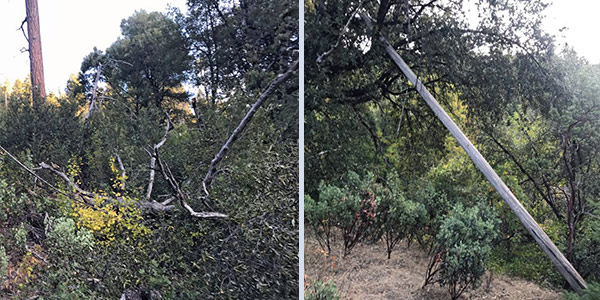By Robert Mullin
California officials on Monday continued to heap criticism on Pacific Gas and Electric for initiating a massive blackout across much of its territory last week, with the state’s top regulator ordering “immediate corrective actions” to the company’s policies and Gov. Gavin Newsom calling for refunds to the 738,000 customers affected.
In a letter to PG&E CEO Bill Johnson, California Public Utilities Commission President Marybel Batjer condemned the utility for “failures in execution” during the largest public safety power shutoff (PSPS) in the state’s history, while directing the company’s top executives and board members to attend an emergency meeting Friday to share what they learned from the controversial shutoff and how they plan avoid a repeat.
“It is critical that PG&E, along with all the other utilities in the state, learn from this event and take steps now to ensure mistakes and operational gaps are not repeated,” Batjer said.
Batjer’s letter followed her harsh comments during last week’s CPUC voting meeting, saying PG&E’s “absolutely unacceptable” measures cannot become the “new normal” for the state. (See PG&E Restores Power amid Backlash.)
The tone of the Oct. 14 letter was more conciliatory, with Batjer commending the cooperation and transparency of PG&E staff who “worked to overcome challenges” during the event. But she also called out PG&E on several shortcomings, including its failure to heed recommendations from state and local agencies, which contributed to a critical breakdown of public communication and coordination. Those recommendations included establishing a communication structure that allows emergency personnel to receive information outside general updates to local governments, developing lists of critical facilities with county and tribal governments, identifying critical fuel-supply needs and coordinating with local governments to select PSPS-specific community resource centers.
Batjer pointed to the performance of PG&E’s website — a “cornerstone” of the company’s public information effort, which crashed within 24 hours of the PSPS declaration. That left PG&E staff struggling “to provide necessary information to their customers, the public and frontline safety officials with affected state, county and tribal governments.”
Batjer also faulted PG&E for failing to scale its operations to meet the increased customer inquiries precipitated by the event. In response, she ordered the company to identify the maximum outage that could occur during a PSPS and ensure “commensurate bandwidth requirements” for web and call services to be available at all times.
Other corrective actions required by the CPUC include:
- Accelerating the restoration of power, with a goal of less than 12 hours — similar to the requirement after major storms;
- Taking steps to minimize the magnitude of future PSPS events;
- Establishing a more effective communication structure with county and tribal government emergency management personnel;
- Improving processes and systems for distributing maps to counties and tribal governments showing the boundaries of the most recent PSPS-affected areas;
- Developing a list of existing and possible future agreements for on-call resources that can be called upon in an emergency;
- Ensuring PG&E personnel involved in PSPS response in emergency operations centers are trained in California’s Standardized Emergency Management System.
‘Right Decision’
In a letter to Batjer Monday, Gov. Newsom lauded the CPUC for its “swift response” to his request for an immediate “comprehensive inquiry” into the PG&E’s blackout event.
But a separate letter to PG&E Corp. CEO Bill Johnson had sharper words, with the governor castigating the company over the “unacceptable scope and duration” of the outages, which he said were “the direct result of PG&E prioritizing profit over public safety, mismanagement, inadequate investment in fire safety and fire prevention measures and neglect of critical infrastructure.”
Newsom also echoed Batjer’s criticism of PG&E for its failure to heed the recommendations of public agencies in executing its PSPS measures.
“PG&E’s lack of preparation and poor performance is particularly alarming given that, prior to the event, top executives responded to the scrutiny and questioning of state and local agencies by asserting that PG&E could handle a public safety power shutoff event,” Newsom wrote. “And PG&E turned down recommendations and offers of assistance from public agencies that are experts in crisis management, including the Governor’s Office of Emergency Services [OES].”
Newsom urged Johnson to have PG&E refund $100 to each residential customer affected by the blackout and $250 to each small business customer.
“This refund should be funded by shareholders, not ratepayers,” Newsom said.
Johnson defended PG&E’s actions, saying the company “closely” coordinated its activities with the CPUC, OES and the California Department of Forestry and Fire Protection before and during the event.
“Representatives from those agencies were embedded in our Emergency Operations Center and we welcomed and accepted their help and counsel, and PG&E employees were also embedded at Cal OES in Sacramento,” Johnson said in a statement. “We also worked closely with county and local officials throughout the PSPS.”
But he also acknowledged there were “areas” where PG&E “fell short of its commitment to serving our customers during this unprecedented event,” specifically in its customer communications.
Still, Johnson pointed to what he considered a key — and positive — outcome of the PSPS: that no fires were sparked in PG&E’s territory. The company has said it recorded about 50 instances of weather-related damage to its equipment in PSPS-impacted areas, including downed lines and vegetation making contact with wires.
“We appreciate the significant impact that turning off power for safety has on our customers and the state. While we recognize this was a hardship for millions of people throughout Northern and Central California, we made that decision to keep customers and communities safe,” Johnson said. “That was the right decision.”





